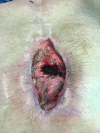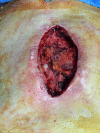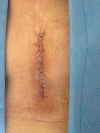Preliminary result with incisional negative pressure wound therapy and pectoralis major muscle flap for median sternotomy wound infection in a high-risk patient population
- PMID: 28901717
- PMCID: PMC7949641
- DOI: 10.1111/iwj.12808
Preliminary result with incisional negative pressure wound therapy and pectoralis major muscle flap for median sternotomy wound infection in a high-risk patient population
Abstract
Deep sternal wound infection (DSWI) represents a dangerous complication that can follow open-heart surgery with median sternotomy access. Muscle flaps, such as monolateral pectoralis major muscle flap (MPMF), represent the main choices for sternal wound coverage and infection control. Negative pressure incision management system has proven to be able to reduce the incidence of these wounds' complications. Prevena™ represents one of these incision management systems and we aimed to evaluate its benefits. A total of 78 patients with major risk factors that presented post-sternotomy DSWI following cardiac surgery was selected. Thrity patients were treated with MPMF and Prevena™ (study group). Control group consisted of 48 patients treated with MPMF and conventional wound dressings. During the follow-up period, 4 (13%) adverse events occurred in the study group, whereas 18 complications occurred (37·5%) in the control group. Surgical revision necessity and mean postoperative time spent in the intensive care unit were both higher in the control group. Our results evidenced Prevena™ system's ability in improving the outcome of DSWI surgical treatment with MPMF in a high-risk patient population.
Keywords: Deep sternal wound infection; Pectoralis major muscle flap; Prevena™.
© 2017 Medicalhelplines.com Inc and John Wiley & Sons Ltd.
Figures





Similar articles
-
First Experiences with Incisional Negative Pressure Wound Therapy in a High-Risk Poststernotomy Patient Population treated with Pectoralis Major Muscle Flap for Deep Sternal Wound Infection.J Reconstr Microsurg. 2018 Jan;34(1):1-7. doi: 10.1055/s-0037-1605379. Epub 2017 Oct 9. J Reconstr Microsurg. 2018. PMID: 28992646
-
Decreasing complications of pectoralis major muscle flap reconstruction with two modalities of negative pressure wound therapy.Scand J Surg. 2022 Jan-Mar;111(1):14574969211043330. doi: 10.1177/14574969211043330. Epub 2021 Sep 5. Scand J Surg. 2022. PMID: 34486448
-
Flap Reconstruction for Deep Sternal Wound Infections: Factors Influencing Morbidity and Mortality.Ann Thorac Surg. 2020 May;109(5):1584-1590. doi: 10.1016/j.athoracsur.2019.12.014. Epub 2020 Jan 23. Ann Thorac Surg. 2020. PMID: 31982440
-
A Review of 559 Sternal Wound Reconstructions at a Single Institution: Indications and Outcomes for Combining an Omental Flap With Bilateral Pectoralis Major Flaps in a Subset of 17 Patients With Infections Extending Into the Deep Mediastinum.Ann Plast Surg. 2023 Jun 1;90(6S Suppl 5):S521-S525. doi: 10.1097/SAP.0000000000003478. Epub 2023 Feb 4. Ann Plast Surg. 2023. PMID: 36752500 Review.
-
Muscle flaps or omental flap in the management of deep sternal wound infection.Interact Cardiovasc Thorac Surg. 2011 Aug;13(2):179-87. doi: 10.1510/icvts.2011.270652. Epub 2011 May 4. Interact Cardiovasc Thorac Surg. 2011. PMID: 21543366 Review.
Cited by
-
Inflammatory biomarkers, vascular procedures of lower limbs, and wound healing.Int Wound J. 2019 Jun;16(3):716-723. doi: 10.1111/iwj.13086. Epub 2019 Feb 17. Int Wound J. 2019. PMID: 30773823 Free PMC article.
-
Efficacy and safety of pectoralis muscle flap combined rectus abdominis muscle sheath fasciocutaneous flap for reconstruction of sternal infection.Int Wound J. 2022 Nov;19(7):1829-1837. doi: 10.1111/iwj.13788. Epub 2022 Mar 15. Int Wound J. 2022. PMID: 35289489 Free PMC article.
-
Closed Incision Negative Pressure Therapy Versus Standard of Care Over Closed Plastic Surgery Incisions in the Reduction of Surgical Site Complications: A Systematic Review and Meta-Analysis of Comparative Studies.Eplasty. 2023 Mar 31;23:e22. eCollection 2023. Eplasty. 2023. PMID: 37187870 Free PMC article.
-
Closed Incision Negative Pressure Therapy: Review of the Literature.Cureus. 2019 Jul 21;11(7):e5183. doi: 10.7759/cureus.5183. Cureus. 2019. PMID: 31565592 Free PMC article. Review.
-
Closed Incisional Negative Pressure Therapy Significantly Reduces Early Wound Dehiscence after Reduction Mammaplasty.Plast Reconstr Surg Glob Open. 2021 Mar 22;9(3):e3496. doi: 10.1097/GOX.0000000000003496. eCollection 2021 Mar. Plast Reconstr Surg Glob Open. 2021. PMID: 33968556 Free PMC article.
References
-
- Mokhtari A, Sjogren J, Nilsson J, Gustafsson R, Malmsjo M, INgemansson R. The cost of vacuum assisted closure therapy in treatment of deep sternal wound infections. Scand Cardiovasc J 2008;42:85–9. - PubMed
-
- Carlesimo B, Ruggiero M, Lo Torto F, Marcasciano M. Imaging and Surgical Principles of Osteomyelitis and Pressure Ulcers. In: Saba L, Rozen WM, Alonso‐Burgos A, Ribuffo D, editors. Imaging for plastic surgery. Boca Raton, Florida, USA: CRC Press, 2014:793–818.
-
- Lucet JC, Batisse D, Brucker G. Mediastinitis after sternotomy. Mortality and hospital length of stay. Groupe parisien detude des sternotomies. Arch Mal Coeur Vaiss 1997;90:471–5. - PubMed
-
- Loop FD, Lytle BW, Cosgrove DM, Mahfood S, McHenry MC, Goormastic M, Stewart RW, Golding LA, Taylor PC. J. Maxwell Chamberlain memorial paper. Sternal wound complications after isolated coronary artery bypass grafting: early and late mortality, morbidity, and cost of care. Ann Thorac Surg 1990;49:179–86; discussion 186–7.. - PubMed
-
- Ridderstolpe L, Gill H, Granfeldt H, Ahlfeldt H, Rutberg H. Superficial and deep sternal wound complications: incidence, risk factors and mortality. Eur J Cardiothorac Surg 2001;20:1168–75. - PubMed
Publication types
MeSH terms
LinkOut - more resources
Full Text Sources
Other Literature Sources
Medical

